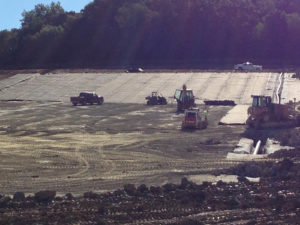
Background
Dubuque Landfill Cell 9, Phase 2, is located in Dubuque, Iowa. The original liner system (from bottom up) consisted of 1ft (30cm) groundwater collection layer, 8oz/sy (270g/m²) separation geotextile, 1ft (30cm) earth barrier layer, 2ft (60cm) compacted clay layer, 60mil (1.5mm) high-density polyethylene (HDPE) liner, 8 oz/sy (270 g/m²) protection geotextile, and 1ft (30cm) leachate collection drainage layer (tire shred), as shown in Figure 1 (p. 17).
The granular drainage layer above the subgrade is designed to control groundwater to mitigate the risk of exposing the compacted clay liner to excessive moisture. Excessive moisture and even saturation will compromise the integrity of the compacted clay liner, reducing the effectiveness of the entire liner system during the design life of the landfill.
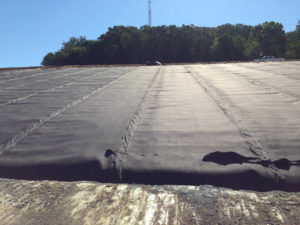
A geonet geocomposite alternative to the granular drainage layer has technical and economic benefits, including air space saving, easy and quick installation, and quality control of the manufactured product. When a geocomposite is used for a groundwater control layer, the combined drainage capacity and capillary barrier, or “break” to control the upward movement of water, is critical to its performance. A geocomposite will succeed as a capillary break only if the top and bottom geotextile do not come in contact with each other, thus providing a void space to break the capillary action from drawing water through the subgrade soil and the bottom geotextile.
Figure 2
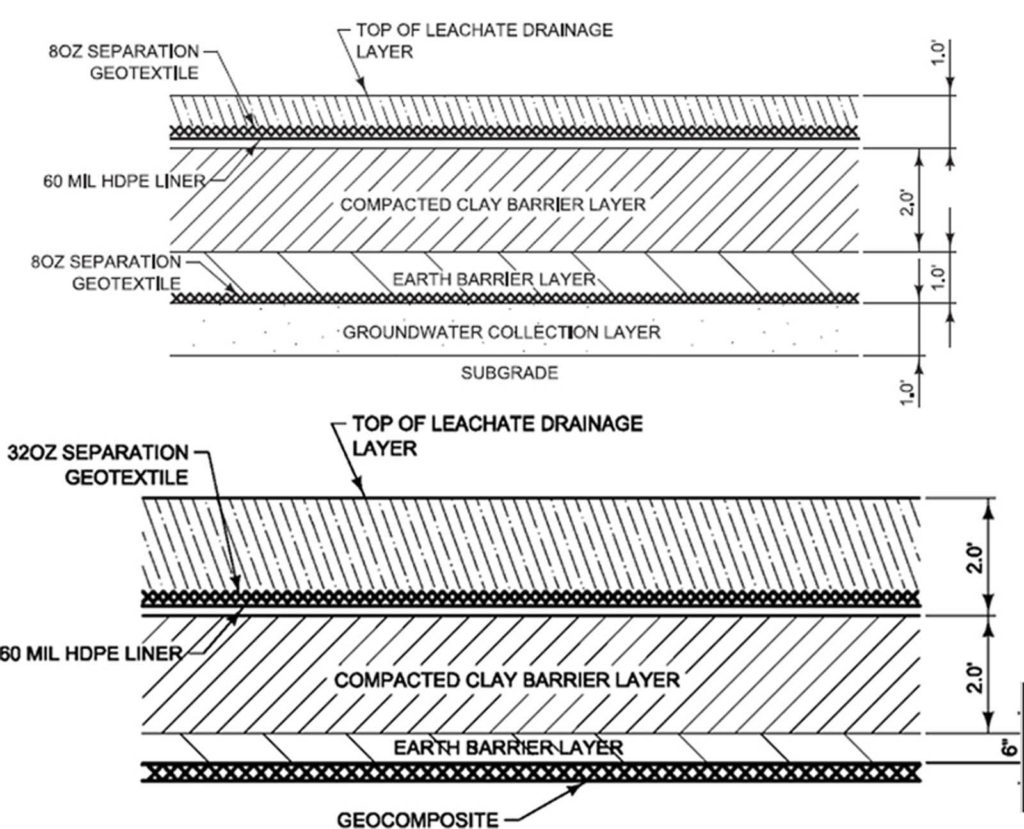
The geocomposite consists of a tri-planar geonet heat-laminated on both sides with a nonwoven geotextile. The tri-planar structure consists of middle ribs that provide direct flow, along with diagonally placed top and bottom ribs to minimize geotextile intrusion. Studies have shown that the tri-planar geocomposites are effective capillary barriers (Henry and Affleck, 1998; Evans, Zhao, and Salzer, 2010).
Iowa state regulations require the granular drainage layer to meet or exceed a hydraulic conductivity of 1 × 10-2 cm/s, and 12in. (30cm) in thickness. A tri-planar geocomposite with the following properties exceeds this requirement.
Engineers on the project were able to redesign the groundwater control layer within a quick time frame. The project had already bid when the alternative groundwater drainage layer was proposed. Engineering had to submit the alternative drainage layer to the Iowa Department of Natural Resources (IDNR) for approval prior to permit construction. The IDNR accepted the alternative groundwater control layer and a change order was issued for the tri-planar geocomposite.
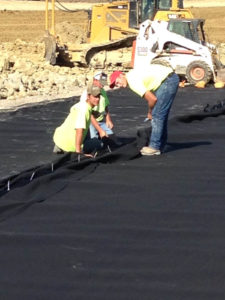
Results
The tri-planar geocomposite was shipped to the jobsite and installed efficiently. This gave the general contractor flexibility to then install the overlying compacted clay liner. The contractor was also able to install a portion of the geocomposite to better fit the construction schedule.
Photo 1 shows geocomposites installed on sideslopes and the preparation of the basal subgrade. Photo 2 shows the geonet overlapping and joined with cable ties. Photo 3 shows the geotextile overlap and seams, with geocomposite installed in an anchor trench along the slopes.
The tri-planar geocomposite alternative on this landfill expansion in place of the 12in. granular groundwater control layer and 6in. of the earthen barrier layer produced a revenue gain of more than $650,000 from the air space savings. In addition to the revenue gain, the geocomposite will provide a consistent drainage layer for any groundwater infiltration over the entire surface area. Also, construction with geocomposite is faster than the 12-in. granular drainage layer, with crews installing 1 to 2 acres of geocomposite per day.
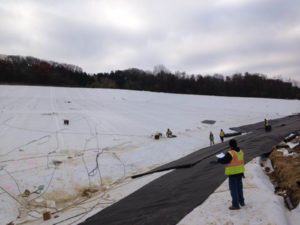
In conjunction with the geocomposite proposition, engineers also approved a white HDPE liner as an alternative to the black HDPE liner in the original design. The white HDPE geomembrane provides a flat surface with fewer wrinkles, which helps reduce damage to the liner when overlying cover soil is spread with heavy equipment.
The chance for reduced damage from equipment and the improved visual damage when exposed make the white-surfaced HDPE liner an enticing alternative to the black HDPE in the original design. Installation of white surfaced geomembrane is shown in Photos 4 and 5.
Vincent Diviacchi, GSE Environmental, Houston, Texas
Chris Oelkers, AECOM (Waterloo, Iowa, office)
Aigen Zhao, Ph.D., P.E., GSE Environmental, Houston, Texas; member of the Editorial Advisory Committee for Geosynthetics magazine
References
Henry K.S and Affleck, R. (1998), “ Freezing tests on lean clay with Tenax tri-planar geocomposite as capillary barrier,” Contract Report to Tenax Inc., from U. S. Army Cold Regions Research and Engineering Laboratory, Hanover, N.H.
Evans, M. Zhao, A., and Salzer, L. (2010), “Geocomposite capillary barrier for groundwater suppression at Lyon County landfill cell and pond construction,” Proc. 9th Intl. Conf. on Geosynthetics, Brazil.
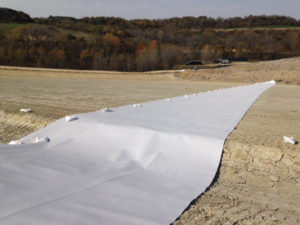
 TEXTILES.ORG
TEXTILES.ORG


